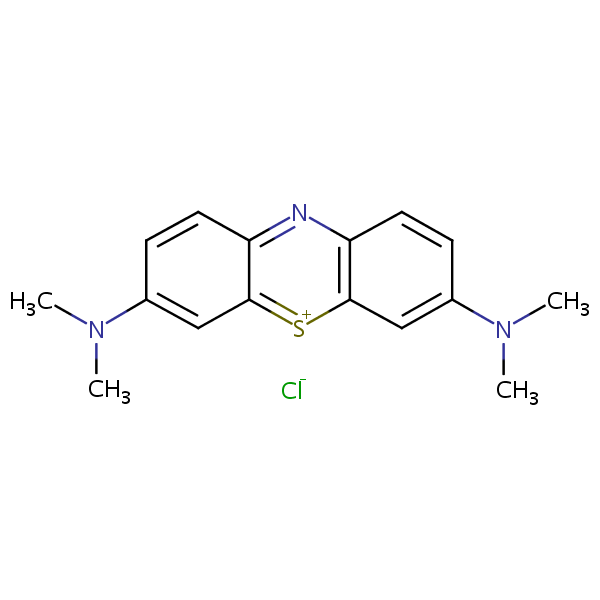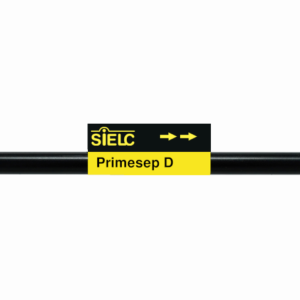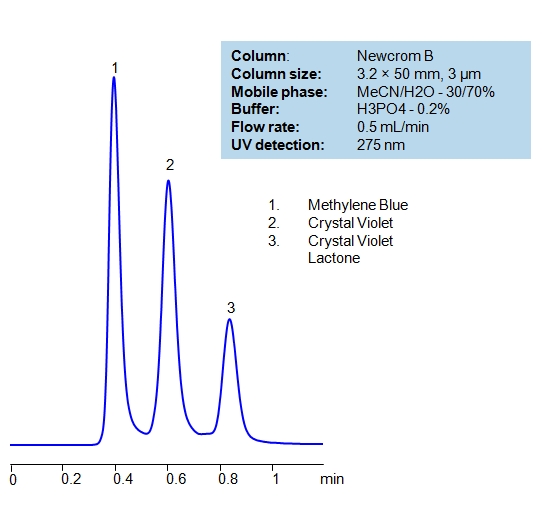| CAS Number | 61-73-4 |
|---|---|
| Molecular Formula | C16H18ClN3S |
| Molecular Weight | 319.851 |
| InChI Key | CXKWCBBOMKCUKX-UHFFFAOYSA-M |
| LogP | 2.72 |
| Synonyms |
|
Applications:
UV-Vis Spectrum of Methylene Blue
July 16, 2024
Access the UV-Vis Spectrum SIELC Library
If you are looking for optimized HPLC method to analyze Methylene Blue check our HPLC Applications library
For optimal results in HPLC analysis, it is recommended to measure absorbance at a wavelength that matches the absorption maximum of the compound(s) being analyzed. The UV spectrum shown can assist in selecting an appropriate wavelength for your analysis. Please note that certain mobile phases and buffers may block wavelengths below 230 nm, rendering absorbance measurement at these wavelengths ineffective. If detection below 230 nm is required, it is recommended to use acetonitrile and water as low UV-transparent mobile phases, with phosphoric acid and its salts, sulfuric acid, and TFA as buffers.
For some compounds, the UV-Vis Spectrum is affected by the pH of the mobile phase. The spectra presented here are measured with an acidic mobile phase that has a pH of 3 or lower.

HPLC Method for Analysis of Methylene blue on Primesep 100 Column
December 7, 2022
High Performance Liquid Chromatography (HPLC) Method for Analysis of Methylene Blue on Primesep 100 by SIELC Technologies.
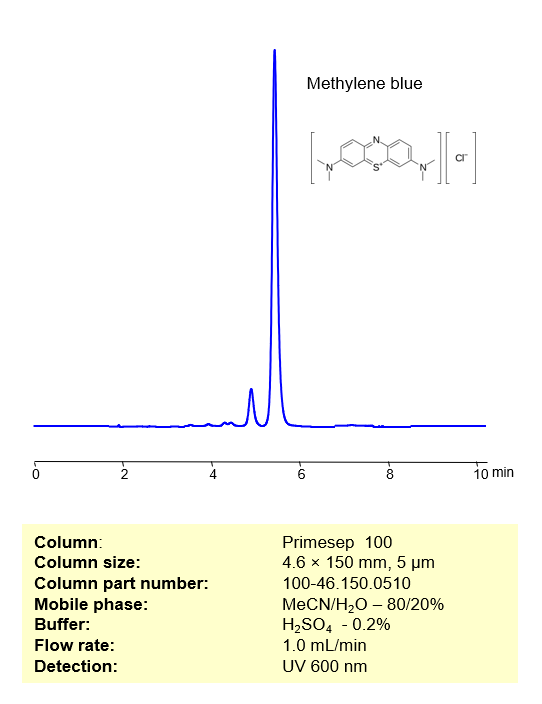
Methylene blue is a synthetic dye with the chemical formula C16H18ClN3S. As a salt, it has medical uses, primarily in treatment of methemoglobinemia. It is also used to treat pain caused by the urinary tract infections and spasms as a combination drug–Methylphen. Commercially, it is often used as a blue dye, though it has a wide variety of other uses including but not limited to sulfide analysis, water testing, and redox indicator. You can find detailed UV spectra of Methylene Blue and information about its various lambda maxima by visiting the following link.
Methylene Blue can be retained and analyzed on a Primesep 100 mixed-mode stationary phase column using an isocratic analytical method with a simple isocratic mobile phase of water, Acetonitrile (MeCN), and a sulfuric acid (H2SO4) buffer. This analysis method can be UV detected at 600 nm with high resolution and peak symmetry.
Condition
| Column | Primesep 100, 4.6 x 150 mm, 5 µm, 100 A, dual ended |
| Mobile Phase | MeCN/H2O – 80/20% |
| Buffer | H3PO4 – 0.2% |
| Flow Rate | 1.0 ml/min |
| Detection | UV, 600 nm |
| Peak Retention Time | 5.92 min |
Description
| Class of Compounds | Dyes |
| Analyzing Compounds | Methylene Blue |
Application Column
Primesep 100
Column Diameter: 4.6 mm
Column Length: 150 mm
Particle Size: 5 µm
Pore Size: 100 A
Column options: dual ended

Analysis of Methylene Blue Purity in Reversed-Phase Cation-Exchange and Reversed-Phase Cation-Exclusion Modes
December 5, 2013
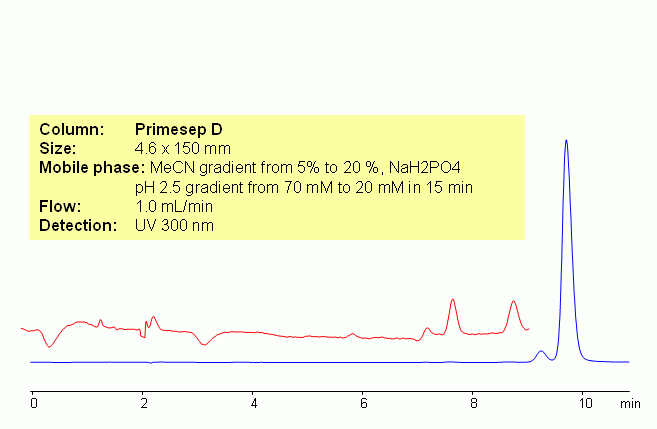
Methylene blue is a heterocyclic dye with a wide range of use in biology and chemistry. Purity of dyes rarely exceed 70% and separation of methylene blue and related impurities is required. Two alternative methods for purity analysis were developed on Primesep C and Primesep D mixed-mode HPLC columns. Primesep C is a reversed-phase cation-exchange (anion-exclusion column) column and Primesep D is reversed-phase anion-exchange (cation-exclusion) column. Various buffers can be used for the method. Depending on the buffer, method can be compatible with UV, LC/MS and prep chromatography. Method can be used for prep separation of methylene blue and related impurities.
| Column | Primesep D, 4.6×150 mm, 5 µm, 100A |
| Mobile Phase | Gradient MeCN – 5-20% |
| Buffer | Gradient NaH2PO4 pH 2.5 70-20mM 15 min |
| Flow Rate | 1.0 ml/min |
| Detection | UV, 300 nm |
>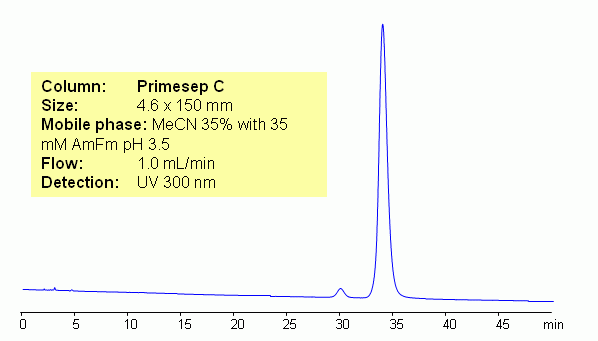
| Column | Primesep C, 4.6×150 mm, 5 µm, 100A |
| Mobile Phase | MeCN – 35% |
| Buffer | AmFm pH 3.5 – 35 mM |
| Flow Rate | 1.0 ml/min |
| Detection | UV, 300 nm |
| Class of Compounds |
Duy, Hydrophobic, Ionizable |
| Analyzing Compounds | Methylene Blue |
Application Column
Primesep D
The Primesep family of mixed-mode columns offers a wide variety of stationary phases, boasting unprecedented selectivity in the separation of a broad array of chemical compounds across multiple applications. Corresponding Primesep guard columns, available with all stationary phases, do not require holders. SIELC provides a method development service available to all customers. Inquire about our specially-tailored custom LC-phases for specific separations.
Select optionsPrimesep C
The Primesep family of mixed-mode columns offers a wide variety of stationary phases, boasting unprecedented selectivity in the separation of a broad array of chemical compounds across multiple applications. Corresponding Primesep guard columns, available with all stationary phases, do not require holders. SIELC provides a method development service available to all customers. Inquire about our specially-tailored custom LC-phases for specific separations.
Select optionsUV Detection

HPLC Dye Separation on SHARC1 Column
July 10, 2013
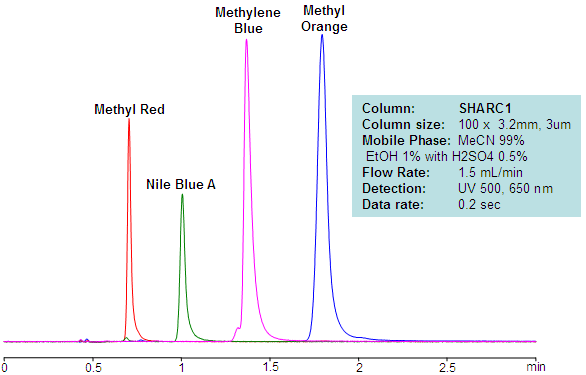
| Column | Sharc 1, 3.2×100 mm, 3 µm, 100A |
| Mobile Phase | MeCN/EtOH – 99/1% |
| Buffer | H2SO4 – 0.5% |
| Flow Rate | 1.5 ml/min |
| Detection | UV, 500, 650 nm |
| Class of Compounds |
Dye, Hydrophilic, Ionizable |
| Analyzing Compounds | Methyl Red, Methyl Orange, Methylene Blue, Nile Blue A |
Application Column
SHARC 1
The SHARC™ family of innovative columns represents the first commercially available columns primarily utilizing separation based on hydrogen bonding. SHARC stands for Specific Hydrogen-bond Adsorption Resolution Column. Hydrogen bonding involves an interaction or attraction between a bound hydrogen atom and molecules containing electronegative atoms, such as oxygen, nitrogen, and fluorine.
Select optionsMethyl Red
Methylene Blue
Nile Blue A

HPLC Separation of Dyes
November 21, 2010
| Column | Newcrom B, 3.2×50 mm, 3 µm, 100A |
| Mobile Phase | MeCN/H2O – 30/70% |
| Buffer | H3PO4 – 0.2% |
| Flow Rate | 0.5 ml/min |
| Detection | UV, 275 nm |
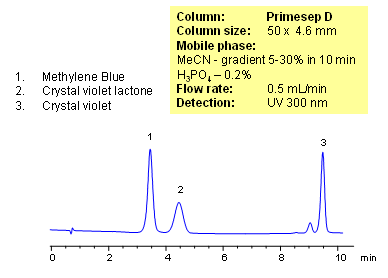
Various dyes are widely used in food, textile, and pharmaceutical industries. Dies are aromatic compounds containing ionizable groups. Methylene blue, crystal violet lactone, and crystal violet were separated on a Primesep D HPLC column. Method can be used for separation of other dyes and pigments that are basic and hydrophobic in nature.
| Column | Primesep D, 4.6×50 mm, 3 µm, 100A |
| Mobile Phase | MeCN |
| Buffer | H3PO4 – 0.2% |
| Flow Rate | 0.5 ml/min |
| Detection | UV, 300 nm |
| Class of Compounds |
Dye, Hydrophilic, Ionizable |
| Analyzing Compounds | Methylene Blue, Crystal violet lactone, Crystal violet |
Application Column
Newcrom B
The Newcrom columns are a family of reverse-phase-based columns. Newcrom A, AH, B, and BH are all mixed-mode columns with either positive or negative ion-pairing groups attached to either short (25 Å) or long (100 Å) ligand chains. Newcrom R1 is a special reverse-phase column with low silanol activity.
Select optionsPrimesep D
The Primesep family of mixed-mode columns offers a wide variety of stationary phases, boasting unprecedented selectivity in the separation of a broad array of chemical compounds across multiple applications. Corresponding Primesep guard columns, available with all stationary phases, do not require holders. SIELC provides a method development service available to all customers. Inquire about our specially-tailored custom LC-phases for specific separations.
Select optionsCrystal Violet Lactone
Methylene Blue

